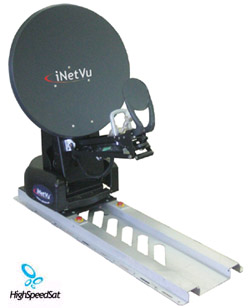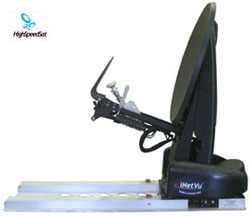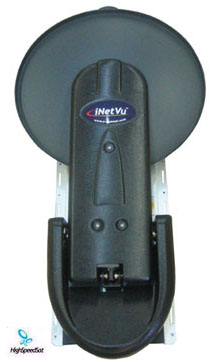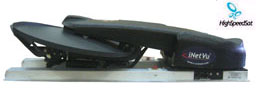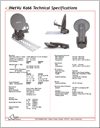iNetVu KA-66
The The iNetVu Ka66 is latest iNetVu Mobile satellite antenna platform, which
was developed to work with the new Ka frequency band , a breakthrough satellite
communications technology. ![]()
The iNetVu Ka66 has been designed to take advantage of this new satellite service which delivers dramatic improvements in two-way, high-speed Internet services for consumers and businesses throughout North America. The Ka66 Mobile Platform has been tested over Telesat Canada’s Anik F2 Satellite and Wildblue (US). The Ka66 is the first mobile satellite internt offering to operate in the Ka-band frequency range. This new product line presents a number of benefits for both residential and commercial users.
Other iNetVu Systems:
- iNetVu 740
- iNetVu 750 (Starband)
- iNetVu 980
- iNetVu 1200
- iNetVu 1800
Ka66 iNetVu mobile satellite Internet system is able to deliver two-way satellite based Internet solutions, VoIP
and Video cost effectively, using a low profile mobile or transportable antenna system that can deliver comparable performance to significantly larger and more expensive
products.
Users of the iNetVu Ka66 Mobile platforms are able to automatically locate the satellite from a vehicle or moveable structure by a simple push of a button and be instantly and securely connected to the Internet at broadband speeds.
C-COM Satellite Systems, Inc. is a leader in the development and deployment of commercial grade mobile satellite-based technology for the delivery of two-way highspeed Internet, VoIP and Video services into vehicles. C-COM has developed a unique proprietary Mobile auto-deploying (iNetVu™) antenna that allows the delivery of highspeed satellite based Internet services into vehicles while stationary virtually anywhere where one can drive. The iNetVu Mobile antenna has also been adapted to be deployable from transportable platforms. The company's satellite-based products and services deliver high-quality, cost-effective solutions for both fixed and mobile applications throughout the world.
K-band Mobile antenna
In July 2004, Telesat successfully launched the Anik F2 satellite. It is the world's largest commercial communications satellite. Anik F2 is the first satellite to fully commercialize the Ka frequency band, a breakthrough satellite communications technology for delivering cost-effective, two-way broadband services.
This state-of-the-art development enables dramatic improvements in access to two-way, high-speed Internet services for consumers and businesses throughout North America. With Telesat's Anik F2, North Americans have access to the most advanced broadband services - anywhere and anytime.
The great advantage of Ka-band over other forms of internet via satellite is that is only requires a 67cm x 75cm dish (26" x 30") to offer any of the four service performance levels. Additionally, Ka-Band uses spot beams to offer internet via-satellite, which makes better use of the available bandwidth than a traditional Ku or C-Band satellite, meaning more users can enjoy a high level of performance. Ka-Band internet is offered via the Anik F2 satellite, located at 111.1°West. If Ku-Band (9.75-12.75GHz) revolutionized television via satellite in the 90s, Ka-Band has revolutionized internet via satellite.
A Ka-Band signal is very narrow: it is approximately 15mm wide, as opposed to 30mm for a Ku-Band and 75mm for a C-Band signal. Given such a narrow signal, Ka-Band is ideal for spot beam distribution: the Ka-Band footprint of Anik F2 consists of 45 spot beams that cover Canada and the United States. Each spot beam is 36MHz wide. The Ka-Band operates in the 18.3-18.8 and the 19.7-20.2 GHz range for downlink frequencies and 28.35-28.60 and the 29.25-30 GHz range for uplink frequencies.
Not unlike C-Band, Ku-Band or any other satellite receive station, Ka signals received by the outdoor unit on the antenna are downconverted into a frequency range that can be carried through coaxial cable - the lower portion of the L-Band (950-1450 MHz). Signals sent to the outdoor unit travel in the 1800 to 2300MHz range, which is why it is critical to use only certified RG6 coaxial cable for Ka-Band installations (such as CommScope 5729 or 5773 RG6 coaxial cable).
Unlike Direcway or other V-Sat terminals (Very Small Aperture Terminal), the Ka-band modem must be located between 50' (15m) and 150' (46m) from the outdoor unit - no more, no less - in order to work properly. If you intend to use your internet via-satellite service more than 150' (46m) away from the outdoor unit, the modem must be installed within the 150' range and the rest of the distance must be covered using approved CAT-5 Ethernet cable. If your modem is located less than 50' (16m) away from the antenna, extra coaxial cable must be left rolled up under the antenna or next to the modem.
In order to amplify the receive and transmit signals, the outdoor unit receives 30VDC from the indoor modem via the transmit coaxial cable. This is one reason why it is critical to use only the highest grade coaxial cable and F-Connectors available.
Basic charge includes a flat fee for the first week's hire with a reducing daily rate per week after that (see rate card). To that you only need to add your call charges, a statement itemising calls will be forwarded to you usually within 7-14 days post-hire to reconcile your account.
One major benefit is a smaller dish size. The Ka66 is only 66cm (26") in diameter, but offers similar speeds to its larger Ku predecessors. For vehicles that have been hindered from acquiring satellite Internet due to height restrictions, the Ka66 and its lowered stow height may be the answer.
Ka service is delivered through concentrated spot beams rather than the large footprints traditionally used in Ku-band. Due to this spot beam structure, service on Ka Band is very flexible. If a storm hits a certain area, more power can be routed to that particular beam to guarantee that the level of service stays as high as possible. Because the beams are managed independently, they can be altered at a moments notice for a specific geographical area, ensuring that any drop in service would be minimal. These spot beams also allow for bandwidth on demand, enabling a user to request an increase or decrease in speed at any time without being locked into a fixed service plan.
KA-66 Mobile (WildBlue) Satellite Internet Specification
| Technical Specifications | |
|---|---|
| Technical Specifications: | |
| Operating Frequency: | 1616 - 1626.5 MHz, L-Band |
| Duplexing Method: | Time Division Duplex(TDD) |
| Multiplexing Method: | TDMA/FDMA (GSM) |
| Link Margin: | 15.5 dB average |
| Average Power: | 0.57 Watts average |
| CEIRP Average: | -1.9 dBW |
| Sensitivity: | -117.9 dBm |
| TX Spurs General EIRP: | -60 dBW |
| TX Spurs GNSS 1559-1605 MHz: | -80 dBW |
| TX Noise GNSS 1559-1650 MHz: | -70 BW/MHz |
| Standard Battery Life : | |
| Continuous Talk Time: | Up to 2hrs (3.2 hours with the optional High Capacity Battery or 5.5 hrs with the optional Ultra High Capacity Battery) |
| Standby Time: | Up to 16hrs (24 hours with the optional High Capacity Battery or 48 hrs with the optional Ultra High Capacity Battery) |
| Mechanical & Environmental: | |
| Weight: | Under 454g (16oz) |
| Dimensions: | 7.60"L x 2.44"W x 2.66 "D (193mm L x 62mm H x 68mm D) |
| Operating Temperature: | -30ºC - 60ºC |
More Mobile Satellite System related links:
iNetVu Frequently Asked Questions - Check questions asked about iNetvuiNetVu Products - Phones, handhelds, docks, internet data sets and accessories.
Satellite Internet Blog - Comment the latest info from satellite internet arena
iNetVu Ka66 Documentation and Manuals
Click onthe thumbnail to download
iNetVu Ka-66
mobile WildBlue
Data Sheet
(PDF, 83K)
Click onthe thumbnail to download
Ka66 User
Manual
(PDF, 4,864K)
